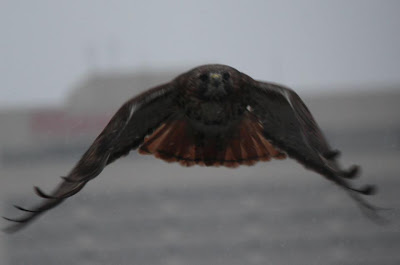Della Micah
From the ground looking up, she is tucked down in the nest bowl with only her head showing.
Kevin Vaughan
The big excitement is when T2 flies in to give Mom a break from sitting on the eggs. This is when we often get a glimpse of those precious eggs around which they tiptalon so carefully.
Katy Mae
Once he arrives, she is outta there! She has complete faith that he will cope with whatever antics the eggs might get up to. T2 looks a little less certain!
Tess Cook
He often arrives with his trademark gift of greenery...
Kevin Vaughan
... and he now has clearly figured out how to break off large pieces with no problem.
Kevin Vaughan
He is also becoming increasingly comfortable with sitting on the eggs, and Mom sometimes has difficulty getting him up and off them when she returns from a break.
Kevin Vaughan
Sometimes, his gifts are edible and those get snatched immediately from him.
Kevin Vaughan
Definitely grab-and go food!
Kevin Vaughan
Kevin Vaughan
She often heads to the flat top of the nearby Civil War monument to eat.
Kevin Vaughan
Kevin Vaughan
Kevin Vaughan
The hawks also use the monument as a food cache, and one morning, Mom cleaned up this large, unidentified food item.
Kevin Vaughan
Kevin Vaughan
Sometimes, after T2 has caught prey, he will first take it to the monument and eat some of it...
Kevin Vaughan
... before heading over to the nest to take the rest back to Mom.
Kevin Vaughan
Kevin Vaughan
Other times, T2 will simply perch there surveying the city scene.
Carolyn Sutton
On Wednesday morning, T2 was very late for his changeover at the nest. Mom finally had to stand up and stretch her legs...
Della Micah
... then her wings
Della Micah
Della Micah
T2 -- call home!
Della Micah
This is how she looked from the front while waiting for T2, tapping her talons, perhaps?
Kevin Vaughan
Eventually, she had no choice but to settle back onto the eggs and wait for him to show up.
Della Micah
Understandably, hawk watchers become nervous when T2 is not where he should be, as we well remember the anxiety and sadness of last year when we watched and waited for Dad, and he never came back.
The following morning, though, all was well in hawkdom as T2 atoned for the previous day's tardiness by bouncing in just after sunrise.
Katy Mae
During this incubation period, hawkwatchers often notice that as Mom settles back onto the eggs, she wriggles and arranges herself quite carefully. What she is doing is positioning her brood patch on top of the eggs to provide maximum warmth. The brood patch is a bare area of skin under the belly feathers.
Here's an image of a red-tail's (not Mom) brood patch, visible only when the wind blows her feathers apart.
John Blakeman offers these additional comments: "Formels, without question, have large, naked brood patches, against which they tuck and rock the eggs into direct contact. But I don't think (but don't yet know with exhaustive knowledge) that tiercels have a full brood patch. It appears to me that they lose only a reduced quantity of the downy breast feathers; that the eggs do get tucked up onto the breast, but not as well as with the formel's naked brood patch. I never saw a brood patch in the sitting tiercel in my Red-Tail breeding project. The brood patch of the sitting formel was very obvious."
Mom's brood patch is under those ruffled feathers, and you can almost see the pinker skin lower down.
Earlier this week, instead of flying into the nest, she landed on the ledge alongside the nest, bringing back memories from last year when she picked up the rat food drops.
Kevin Vaughan
New hawk watchers will see this ledge used extensively later in May and June when the eyasses are old enough to explore outside the nest.
Kevin Vaughan
What an imposing, beautiful hawk Mom is.
Kevin Vaughan
Kevin Vaughan
Whatever the excitement or travails of the day, by night fall she is always on the nest protecting the eggs from the chilly nights we're still having here in Philadelphia.
Katy Mae
Every day, Kevin Vaughan shares his incredible images of these hawks on the Hawkaholic Facebook page. Here are some recent spectacular ones!
Here's T2:
Kevin Vaughan
Kevin Vaughan
T2 rarely looks intimidating...
Kevin Vaughan
Kevin Vaughan
... but in this image, he looks unusually fierce.
Kevin Vaughan
And now for Mom:
Kevin Vaughan
She almost always looks fierce, but here's a more pensive view.
Kevin Vaughan
Kevin Vaughan
Kevin Vaughan
Kevin Vaughan





















































Always a pleasure to read your updates Della. It IS interesting that the males always have the sweeter expression than the females. I wonder how Barnes feels about all the greenery they are losing? ;-)
ReplyDeleteAnn F.
This was a fascinating post. I recall John Blakeman telling us about the brood patch, but this discussion gave me more information. The photo showing it was great. I enjoyed Kevin's photos, and the one that Carolyn took was gorgeous - T2 surveying the scene at the top of the monument.
ReplyDeleteI love your writing and story-telling ability, but this time was special. You managed to make the waiting game a pleasure!
Thanks, again.
Joyce
WOW.... this is taking FOREVER!!
ReplyDeleteOnce again, great writing and story telling. I love the part about how T2 'will cope with whatever antics the eggs might be up to'. Because we all know how crazy unhatched eggs can get! Thanks Della, and Kevin, and all the other photographers, as always. Great jobs all around. Jan B. from CA
ReplyDeleteReading this post and looking at all the amazing photos put a much needed smile on my face. Thank you
DeleteNikki G from NJ